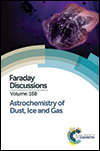Diffusion of atomic oxygen relevant to water formation in amorphous interstellar ices
Abstract
Molecular dynamics (MD) simulations together with accurate physics-based force fields are employed to determine the mobility of atomic oxygen in amorphous ice at low temperatures, characteristic for conditions in interstellar ices. From the simulations it is found that the mobility of atomic oxygen ranges from 60 to 480 Å2 ns−1 in amorphous ice at temperatures between 50 and 200 K. Hence, the simulations establish that atomic oxygen is mobile to a certain degree and a chemical mechanism for water formation involving oxygen mobility is a realistic scenario. This is also confirmed by the computed migration barriers for oxygen diffusion by multiple umbrella sampling simulations, which yield barriers for diffusion in the range of 0.7–1.9 kcal mol−1. The physics-based force field – based on a multipolar expansion of the electrostatic interactions – yields more pronounced energetics for oxygen migration pathways compared to the conventional point-charge models employed in typical simulations. Once formed, the computed solvation free energy suggests that atomic oxygen thermodynamically prefers to be localized inside amorphous ice and is available for chemical reaction, which may be relevant to water formation in and on grains.
- This article is part of the themed collection: Astrochemistry of Dust, Ice and Gas

 Please wait while we load your content...
Please wait while we load your content...